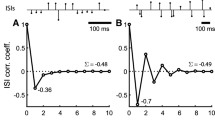Abstract
A PARADOX that exists in auditory and electrosensory neural systems1,2 is that they encode behaviourally relevant signals in the range of a few microseconds with neurons that are at least one order of magnitude slower. The importance of temporal coding in neural information processing is not clear yet3–8. A central question is whether neuronal firing can be more precise than the time constants of the neuronal processes involved9. Here we address this problem using the auditory system of the barn owl as an example. We present a modelling study based on computer simulations of a neuron in the laminar nucleus. Three observations explain the paradox. First, spiking of an 'integrate-and-fire' neuron driven by excitatory postsynaptic potentials with a width at half-maximum height of 250 μs, has an accuracy of 25 μs if the presynaptic signals arrive coherently. Second, the necessary degree of coherence in the signal arrival times can be attained during ontogenetic development by virtue of an unsupervised hebbian learning rule. Learning selects connections with matching delays from a broad distribution of axons with random delays. Third, the learning rule also selects the correct delays from two independent groups of inputs, for example, from the left and right ear.
Similar content being viewed by others
References
Carr, C. E. Annu. Rev. Neurosci. 16, 223–243 (1993).
Heiligenberg, W. Neural Nets in Electric Fish (MIT Press, Cambridge, MA, 1991).
Hopfield, J. J. Nature 376, 33–36 (1995).
Bialek, W., Rieke, F., de Ruyter van Steveninck, R. R. & Warland, D. Science 252, 1854–1857 (1991).
Abeles, M. in Models of Neural Networks II (eds Domany, E., van Hemmen, J. L. & Schulten, K.) 121–140 (Springer, New York, 1994).
Shadlen, M. N. & Newsome, W. T. Curr. Opin. Neurobiol. 4, 569–579 (1994).
Softky, W. R. Curr. Opin. Neurobiol. 5, 239–247 (1995).
Mainen, Z. F. & Sejnowski, T. J. Science 268, 1503–1506 (1995).
Softky, W. & Koch, C. J. Neurosci. 13, 334–350 (1993).
Jeffress, L. A. J. Comp. Physiol. Psychol. 41, 35–39 (1948).
Moiseff, A. & Konishi, M. J. Comp. Physiol. A 144, 299–304 (1981).
Knudsen, E. I., Blasdel, G. G. & Konishi, M. J. Comp. Physiol. 133, 1–11 (1979).
Sullivan, W. E. & Konishi, M. J. Neurosci. 4, 1787–1799 (1984).
Reyes, A. D., Rubel, E. W. & Spain, W. J. J. Neurosci. 14, 5352–5364 (1994).
Reyes, A. D., Rubel, E. W. & Spain, W. J. J. Neurosci. 16, 993–1007 (1996).
Manis, P. B. & Marx, S. O. J. Neurosci. 11, 2865–2880 (1991).
Oertel, D. J. Neurosci. 3, 2043–2053 (1983).
Carr, C. E. Advances in Hearing Research (eds Manley, G. A. et al.) 24–30 (World Scientific, Singapore, 1995).
Carr, C. E. & Konishi, M. J. Neurosci. 10, 3227–3246 (1990).
Hebb, D. O. The Organization of Behavior (Wiley, New York, 1949).
Herz, A., Sulzer, B., Kühn, R. & van Hemmen, J. L. Biol. Cybernet. 60, 457–467 (1989).
Bliss, T. V. P. & Collingridge, G. L. Nature 361, 31–39 (1993).
Debanne, D., Gähwiler, B. H. & Thompson, S. M. Proc. Natl Acad. Sci. USA 91, 1148–1152 (1994).
Markram, H. & Sakmann, B. Soc. Neurosci. Abstr. 21, 2007 (1995).
Goldberg, J. M. & Brown, P. B. J. Neurophysiol. 32, 613–636 (1969).
Yin, T. C. T. & Chan, J. C. K. J. Neurophysiol. 64, 465–488 (1990).
Georgopoulos, A. P., Schwartz, A. B. & Kettner, R. E. Science 233, 1416–1419 (1986).
Salinas, E. & Abbott, L. F. J. Comput. Neurosci. 1, 87–107 (1994).
Braitenberg, V. Network 4, 11–17 (1993).
Bernander, Ö., Douglas, R. J., Martin, K. A. C. & Koch, C. Proc. Natl Acad. Sci. USA 88, 11569–11571 (1991).
Author information
Authors and Affiliations
Rights and permissions
About this article
Cite this article
Gerstner, W., Kempter, R., van Hemmen, J. et al. A neuronal learning rule for sub-millisecond temporal coding. Nature 383, 76–78 (1996). https://doi.org/10.1038/383076a0
Received:
Accepted:
Issue Date:
DOI: https://doi.org/10.1038/383076a0
- Springer Nature Limited
This article is cited by
-
Synchronization of delayed coupled neurons with multiple synaptic connections
Cognitive Neurodynamics (2024)
-
Neuronal and synaptic adaptations underlying the benefits of deep brain stimulation for Parkinson's disease
Translational Neurodegeneration (2023)
-
The plasticitome of cortical interneurons
Nature Reviews Neuroscience (2023)
-
Neural encoding with unsupervised spiking convolutional neural network
Communications Biology (2023)
-
Synchronization in STDP-driven memristive neural networks with time-varying topology
Journal of Biological Physics (2023)





